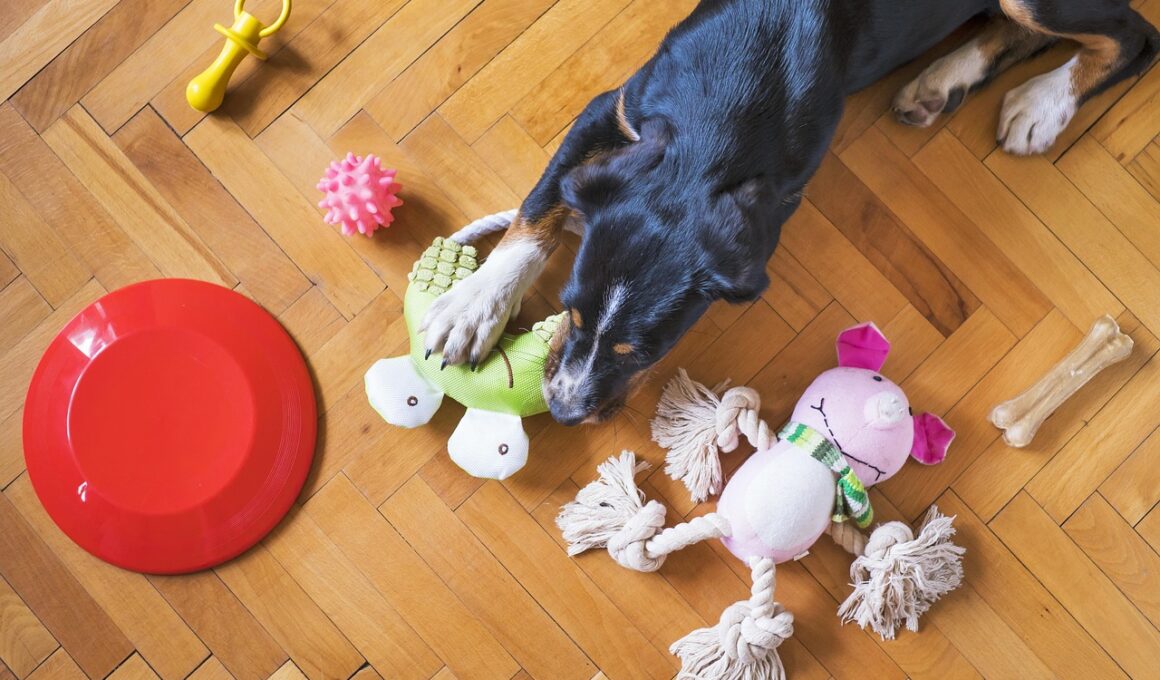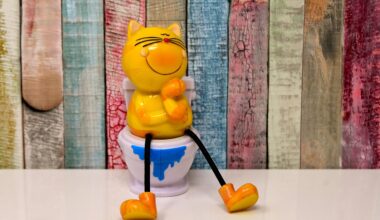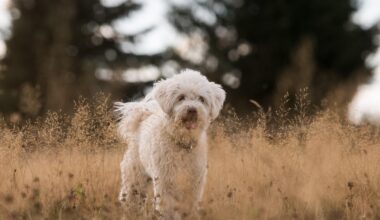How to Manage and Correct Destructive Chewing Behaviors
Destructive chewing is a common issue among dogs, and it can be quite frustrating for pet owners. Many dogs chew on furniture, shoes, and other household items, leading to property damage and behavioral concerns. Understanding the causes of destructive chewing is crucial for developing effective management techniques. Dogs may chew due to boredom, anxiety, or the instinctual need to chew. It is vital to identify the specific triggers in your dog’s environment. By acknowledging these factors, you can begin to address and reduce your dog’s chewing behaviors effectively. Providing appropriate outlets for chewing, such as toys or chew bones, can also prevent destructive behaviors from developing. Ensure that your dog has a variety of appropriate chew items to keep them engaged and reduce excessive chewing on inappropriate objects. Training your dog to follow commands and redirect their focus when they begin to chew on forbidden items is essential. Positive reinforcement techniques, like treats and praise, can help reinforce good behavior. Consistency and patience are key to modifying your dog’s chewing habits, so make sure to regularly monitor and guide your dog appropriately throughout the training process.
In addition to management strategies, understanding the types of chew toys available can make a significant difference in addressing chewing behavior. There are various kinds of chew toys designed for different chewing styles and preferences. Selecting durable and safe options, such as rubber toys or natural bones, can provide lasting engagement for your dog. It’s important to choose chew toys based on your dog’s size, breed, and chewing strength. Also, consider rotating toys to maintain your dog’s interest and keep them stimulated. Interactive toys can also encourage problem-solving skills while satisfying their chewing urge. Providing chew toys that offer treats or food rewards can make chewing more enjoyable for your dog. This approach helps satisfy their natural instinct to chew while preventing destructive behaviors. Always supervise your dog while they are enjoying chew toys to ensure their safety. Regularly inspect toys for wear or damage and replace them as necessary. In addition, engage your dog in regular exercise and mental challenges to alleviate boredom, which can be a significant contributor to destructive chewing. Taking these proactive steps can help you minimize your dog’s chewing issues over time.
Creating a Chewing-Friendly Environment
It’s essential to create a dog-friendly environment that minimizes opportunities for destructive chewing. Start by removing any appealing items that your dog tends to chew on. This includes shoes, furniture, and electrical cords. Consider using baby gates to confine your dog’s access to certain areas of the house, particularly where they may find tempting items to chew. Providing a designated space for your dog with their toys can create a positive area for them. Designate one area of your home as their safe zone filled with appropriate chew toys and cozy beds. Utilize methods like leaving puzzles or engaging toys when leaving your dog alone to keep them entertained and distracted. This practice helps divert their attention from potentially harmful or destructive behaviors. Additionally, using deterrents can help prevent your dog from chewing on unwanted items. Products made for this purpose often have unpleasant tastes that discourage chewing. Reward your dog for chewing on appropriate items and encourage them when they choose their toys over household items. Consistency with these techniques will ultimately help in creating a more harmonious environment for both you and your dog.
Training your dog to respond to commands is vital in curtailing chewing behaviors. Teaching commands such as “leave it” or “no” can effectively redirect your dog when they begin to chew on inappropriate items. Reinforcing these commands with high-value treats or praise can encourage compliance. Consistency is essential, so practice these commands regularly in a low-distraction environment. Gradually increase the challenges by practicing in more stimulating environments, reinforcing your dog’s understanding of these commands. Additionally, positive reinforcement works wonders in behavior modification, so remember to reward successful alternatives when your dog diverts their attention away from prohibited chewing. Training sessions should be succinct and engaging to capture your dog’s attention effectively. Aim for short, constructive sessions that won’t overwhelm your dog. Focus on clear communication between you and your dog, ensuring they understand what is acceptable to chew and what is not. Patience is crucial, as improving chewing behavior will take time and consistent effort. If your dog struggles with training, consider seeking help from a professional dog trainer who specializes in behavioral issues to ensure continued progress toward modification.
Understanding the Role of Exercise and Mental Stimulation
Providing sufficient exercise and mental stimulation is crucial to reducing destructive chewing behavior. Dogs often chew due to pent-up energy or boredom, making it vital to engage their bodies and minds. Regular walks, playtime, and interactive games can help alleviate excessive energy and frustration. Additionally, mental stimulation can be achieved through puzzle toys that challenge your dog’s skills and keep them engaged. Training sessions and trick training can also serve as great avenues for providing mental challenges while reinforcing your bond. Furthermore, scheduled playdates with other dogs can provide social interaction, which is beneficial for your dog’s overall demeanor. Vary your routine by introducing new activities, environments, and social situations to keep your dog interested. Such variations can help break the monotony that may lead to destructive chewing. Consider incorporating play sessions into your daily routine to provide consistent opportunities for both physical and mental engagement. A sufficiently tired dog is less likely to engage in destructive chewing behaviors. Aim to establish a balanced routine that includes ample exercise and mental challenges, contributing positively to your dog’s behavioral development and happiness.
Additionally, keeping a consistent schedule is beneficial for your dog’s overall well-being and can significantly reduce chewing issues. Establishing a daily routine helps your dog understand when to expect meals, playtime, and walks, providing them with structure and predictability. Predictability can alleviate anxiety, which is often a trigger for destructive behaviors. Coordinating meal times, exercise, and relaxation periods can contribute positively to your dog’s day-to-day comfort and stability. Ensuring that your dog has the opportunity to socialize with other dogs and humans can also play a vital role in managing their behavior. Regular socialization helps improve your dog’s confidence and sets a foundation for better behavioral responses. Additionally, consider integrating training and problem-solving games into daily interactions for extra enrichment. This engagement can enhance your relationship with your dog while teaching them valuable skills. Establish family rules and consistency among all household members regarding behavior expectations. This approach can minimize confusion and help your dog comprehend what is appropriate and what isn’t. Bringing these structured practices into your dog’s daily life can significantly contribute to reducing destructive chewing.
Seeking Professional Guidance
Lastly, if you find that all strategies have been implemented and destructive chewing persists, consider consulting a professional dog trainer or behaviorist. They can assess your dog’s specific behaviors and provide tailored advice based on their unique needs. Sometimes, underlying behavioral issues or anxiety may require special attention or intervention. A professional can help identify triggers and develop a comprehensive training plan focused on correcting the underlying problem. Additionally, they might offer guidance on appropriate chew items and reinforcement techniques tailored to your dog. Implementing their strategies effectively can also expedite progress toward correcting your dog’s chewing habits. Don’t hesitate to seek assistance; it can often save time and prevent further complications in managing your dog’s behavior. Remember to remain consistent with any plan introduced by professionals and be willing to adjust approaches based on your dog’s progress. Finally, owning a dog can be quite rewarding, and addressing destructive chewing behaviors takes time and commitment. With commitment and the right guidance, you can foster a positive environment for your dog.
In conclusion, managing and correcting destructive chewing behaviors in dogs requires a multifaceted approach. By identifying triggers, providing appropriate chew toys, creating a safe environment, and reinforcing training commands, pet owners can make significant strides toward resolving chewing issues. Consistency and patience in training and reinforcing good behavior are crucial to success. Regular exercise and mental stimulation are fundamental components of a dog’s well-being, and they can prevent destructive chewing when incorporated into your dog’s daily routine. Establishing a structured schedule not only promotes stability but also helps mitigate anxiety, which can exacerbate chewing tendencies. If necessary, consulting a professional can provide personalized strategies tailored to your dog’s specific situation. Remember, that every dog is unique; thoughtful consideration of their needs will benefit both you and your furry friend. With the right techniques and dedicated effort, you can guide your dog away from destructive chewing and promote healthier habits. Make sure to celebrate small victories and maintain a positive attitude throughout training. This shared journey will ultimately strengthen the bond between you and your dog, making for a happier, healthier pet and home.


